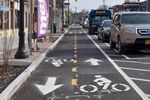Addressing Reluctant Traffic Engineers at NYSDOT - Bike ...
←
→
Page content transcription
If your browser does not render page correctly, please read the page content below
Addressing Reluctant Traffic Engineers at NYSDOT
Many traffic engineers are reluctant to change roads they control. Be prepared to address common concerns.
(While this document focuses on the New York State Dept. of Transportation, most concepts apply to any DOT.)
NYSDOT Has Built 2-way/1-side Cycle Paths
A 2-way mobility lane on one side of a street is the best option under certain circumstances. A key advantage
of this configuration is the space savings from only needing one buffer/barrier, instead of the two required by
1-way lanes on both sides of the street. If your local engineer is wary of this layout, inform them that NYSDOT
recently built protected cycle tracks on four State roads.
Route 266 (Niagara St), Buffalo Route 32 (Broadway), Kingston Route 100, Briarcliff Manor
DOT Region 5. Completed November 2021. DOT Region 8. Completed January 2022. DOT Region 8. Completed November 2020.
Note: design integrates many driveways. Credit: Tania Barricklo/The Daily Freeman Note: box beam median barrier; strong
Credit: GObike Buffalo protection, only needs a little width.
Credit: Bike Tarrytown
Not pictured is Rt 5 (Erie Blvd) in Syracuse between N Beech St and Teall Ave. It is similar to Buffalo's facility.
USDOT and AASHTO Say “Narrow” Lanes are OK
Fitting active transportation facilities within existing rights of way may necessitate making some motor
vehicle lanes less than 12 feet wide. Fortunately, narrower lanes are kosher -- even on truck routes.
“The width of travel lanes is limited by the physical dimensions of automobiles and trucks to a range between
2.7 and 3.6 m (9 and 12 ft). Generally, as the design speed of a highway increases, so must the lane width to
allow for the lateral movement of vehicles within the lane. However, constricted right-of-way and other
design restrictions can have an impact on this decision. Chapter IV of the Green Book recognizes the need for
flexibility in these cases:”
Although lane widths of 3.6 m [12 ft] are desirable... there are circumstances that necessitate the use of lanes
less than 3.6 m wide. In urban areas where right-of-way and existing development become stringent controls,
the use of 3.3 m [11 ft] lanes is acceptable. Lanes 3.0 m [10 ft] wide are acceptable on low-speed facilities.
Lanes 2.7 m [9 ft] wide are appropriate on low-volume roads in rural and residential areas. 1
In populated areas, narrower lanes are actually preferable; they persuade people to drive more carefully. 2
Turn lanes are an easy places to trim space from, particularly in locations where few people turn.
Sub-12-foot travel lanes are easiest to pull off in areas with one
or more of the following: painted medians, turn lanes, no
parking. These give drivers some extra margins for wavering.
NYSDOT Frequently Uses “Narrow” Lanes
There are numerous locations where the State DOT has installed
lanes less than 12' wide. One example is US Route 9 at Hemlock
Dr in Sleepy Hollow (diagram, right), which has 4 lanes, ranging
from 8.5 to 9.5 feet wide.
1 USDOT, Flexibility in Highway Design, 2004, p 76. https://www.fhwa.dot.gov/environment/publications/flexibility/
2 NACTO, Urban Street Design Guide, “Lane Width.” https://nacto.org/publication/urban-street-design-guide/street-design-elements/lane-
width/Better Design Guidelines
The bicycle facility design specifications published by AASHTO in 2012 3 and NYSDOT in 20154 are targeted
toward the small number of people who are already confident cycling with motor vehicles. Modern standards
aim to get cautious people cycling for local trips. Some examples include:
• USDOT's Separated Bike Lane Planning and Design Guide (2015)5
• NACTO's Urban Bikeway Design Guide6
• An improved version of AASHTO bicycle facility guide is in the works 7
The welcome mat for using better guidelines was laid in January 2022, when the Federal Highway
Administration adopted regulations that say “public entities may wish to also reference other documents to
inform the planning and design process [in order to develop] transportation projects that incorporate safe
and convenient walking and bicycling facilities. Such projects improve safety for all modes, create more
equitable access to transportation, and combat climate change.”8
Several organizations wrote Governor Hochul in January 2022 requesting the DOT improve its manual. 9
Liability is Not a Problem
“Designers may be tempted to be very conservative and avoid innovative and creative approaches to design
problems. Avoiding unique solutions is not the answer. Adherence to standard practices [does not]
automatically [establish] that reasonable care was exercised. Deviation from guidelines does not
automatically establish negligence. The best defense is to present persuasive evidence that the guidelines
were not applicable or could not be reasonably met. It is highly recommended
that designers document their rationales for decisions.”10
Not Changing Roads is the Liability
New York State's highest court found New York City liable in the death of a
child who was cycling because, in part, there “was a rational process by which
the jury could have concluded that traffic calming measures deter drivers from
speeding, and that the City's failure to conduct a traffic calming study and to
implement traffic calming measures was a substantial factor in causing the
accident.”11 A crashed car on Broadway (Route 9)
in Irvington, NY.
Similarly, the high court found New York State liable for a person's death at a treacherous intersection
because “once on notice of the dangerous condition, it was the State’s burden to take reasonable steps in a
reasonable amount of time. Instead, it did nothing.”12
3 AASHTO, Guide for the Development of Bicycle Facilities, 4th ed, 2012.
https://njdotlocalaidrc.com/perch/resources/aashto-gbf-4-2012-bicycle.pdf
4 NYSDOT, Highway Design Manual, Chapter 17, Bicycle Facility Design, 2015.
https://www.dot.ny.gov/divisions/engineering/design/dqab/hdm/chapter-17
5 USDOT, Separated Bike Lane Planning and Design Guide, 2015.
https://www.fhwa.dot.gov/environment/bicycle_pedestrian/publications/separated_bikelane_pdg/page00.cfm
6 NACTO, Urban Bikeway Design Guide. https://nacto.org/publication/urban-bikeway-design-guide/
7 Sagar Onta (Toole Design), presentation to Western ITE's Annual Meeting, 2018.
https://www.westernite.org/annualmeetings/18_Keystone/Presentations/5B/5B.SagarOnta.AASHTO%E2%80%99s%20%20Green
%20Book%20for%20Bikes.pdf
8 FHWA, Design Standards for Highways, 2022, p 36.
https://www.federalregister.gov/documents/2022/01/03/2021-28236/design-standards-for-highways
9 Coalition letter to Governor Hochul, 2022. https://biketarrytown.org/new-york-state/bicycle-facility-design-manual-nysdot-hochul.pdf
10 USDOT, Flexibility in Highway Design, 2004, p 40. Edited for brevity.
11 NY Court of Appeals, Turturro v City of New York, 2016, p 20.
https://www.nycourts.gov/ctapps/Decisions/2016/Dec16/196opn16-Decision.pdf
12 NY Court of Appeals, Brown v State of New York, 2018, pp 4-5.
https://nycourts.gov/courts/appeals/Decisions/2018/Jun18/66-67opn18-Decision.pdfNYSDOT Projects Must Consider Cycling Improvements
“Roadway conditions should be examined during scoping and design whenever highways are being
constructed, reconstructed or resurfaced... Adaptations that are responsive to bicyclists' requirements should
be discussed in the scoping and design approval documents. These documents should discuss any decisions
made regarding whether or not improvements that would better accommodate bicycling are incorporated.” 13
Prioritizing Cycling is a Strategy in the State's Climate Plan
Dramatically growing utilitarian cycling is necessary to meet NY's ambitious emission goals. The NYS Climate
Action Council's recently released draft plan includes Strategy T8, calling on the State to “prioritize,
incentivize, and expand access to funding for bike, pedestrian, transit, and complete streets projects” 14
Complete Streets Policy
Projects subject to Department of Transportation oversight “shall consider the convenient access and mobility
on the road network by all users of all ages, including motorists, pedestrians, bicyclists, and public
transportation users through the use of complete street design features in the planning, design, construction,
reconstruction and rehabilitation, but not including resurfacing, maintenance, or pavement recycling.” 15
Cultivating New Cyclists
Plenty of public officials think we're asking them to placate some fixed number
of constituents who cycle already. Nope. What we're really requesting is to
create the conditions that will cultivate new cyclists from folks who are
presently too scared to bike. Making streets safe will get many more people
biking for short trips, like school, soccer practice, and shopping. Journeys like
these make up most trips people take.16
Protected Facilities are Key
Paint is not protection. People who don't bike, scoot, or wheelchair now are
looking for physical barriers on busy roads. They don't want to encounter
Kid holding a sign saying "I want to
people driving who (intentionally or inadvertently) park, drive, or crash into
bike to my friends houses but I'm
the mobility lane. #2scared2bike on Route 9."
Connect to Detestations
Would you build a bridge to nowhere? Or one that goes
only 3/4 of the way across a river? Make sure each
cycling facility reaches all the way to a key destination.
Otherwise, people won't use it.
Drawing: road merging into train tracks. Caption: Damn, the road
lane ends again! I hate sharing the tracks with the train.
13 NYSDOT, Highway Design Manual, Chapter 17, Bicycle Facility Design, 2015, p 17-5.
14 NYS Climate Action Council, Draft Scoping Plan, 2022, p 114. https://climate.ny.gov/Our-Climate-Act/Draft-Scoping-Plan
15 NYS Legislature, S5411A, 2011. https://www.nysenate.gov/legislation/bills/2011/s5411/amendment/a
16 Bike Tarrytown's tabulation of the USDOT's National Household Travel Survey, 2017. Cumulative person trips: 19% are < 1 mile, 34% <
2 miles, 43% < 3 miles, 54% < 4 miles, 61% < 5 miles, 66% < 6 miles, 78% < 10 miles, 86% < 15 miles.It Works
Dedicated infrastructure investments by Seville,
Spain resulted in 5.5 times more people cycling
from 2006 - 2011.17 Paris' automated counters
saw 2.4 times more people cycling in 2021 than
in 2015 due to that city's dramatic changes. 18
NYC's concerted street changes created 5.7 times
more riders from 2001 to 2013.19
8 people cycling in a protected mobility lane on 2nd Ave in NYC. This still is
from a video in which bikes were 26% of vehicles on the avenue.
Lives Over Level of Service
The way people talk about motor vehicle Level of Service (LOS) makes it seem like people
get stuck at intersections forever. Have you ever seen a skeleton driving? Of course not. On
the other hand, that obsession obliterates the convenience and safety of people outside
cars. The result is crashes in 2020 killed 6,236 people walking and 891 people cycling. 20
Photo of skeleton
driving a car.
It's time to place lives over Level of Service. Doing so
is easy because travel choices are highly malleable. Before making a
trip, people weigh each available mode and route for when it is best to
go, how long it takes, cost, and safety. Because gas is cheap and streets
are free, time spent in congestion or looking for parking are the only
marginal cost people incur. For local trips, walking and cycling can be
time competitive with driving... if we make it safe to do so.
A related line of thinking is “congestion increases emissions.” While Firefighters handling wheelchair struck by
true in the immediate sense, efforts that make it easier to drive lead to person driving a car.
more driving, producing more pollution overall. In addition, emissions from idling are increasingly irrelevant
due to the rapidly expanding deployment of automatic stop-start, hybrid, and electric technologies. These are
some of the reasons California's environmental review law demoted LOS as a metric. 21
17 Marques, How Infrastructures Can Promote Cycling in Cities: Lessons from Sevilla, 2015, p 34.
https://personal.us.es/marques/Marques-Infrastructures_Sevilla_v3.pdf
18 Bike Tarrytown, calculated from graph on https://www.paris.fr/pages/bilan-des-deplacements-a-paris-en-2020-8121 and text on
https://www.paris.fr/pages/paris-a-velo-225
19 Bike New York and Bike Tarrytown, 2022. https://biketarrytown.org/new-york-state/nyc-bridge-counts-2001-2020.pdf
20 USDOT, National Roadway Safety Strategy, 2022, p 10. https://www.transportation.gov/NRSS
21 Streetsblog, “At Last, New Rules Are Final: Car Delay Is (Sometimes) NOT an Environmental Impact,” 2019.
https://cal.streetsblog.org/2019/01/04/at-last-new-rules-are-final-car-delay-is-sometimes-not-an-environmental-impact/You can also read



























































